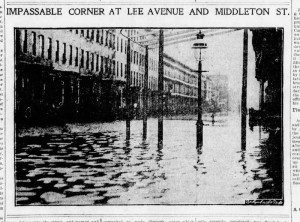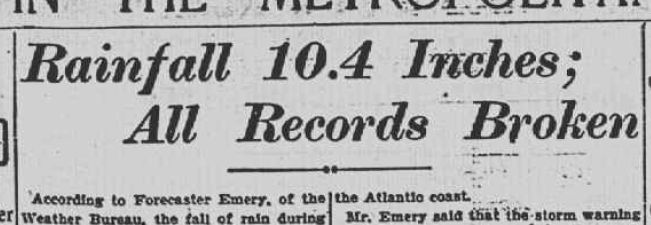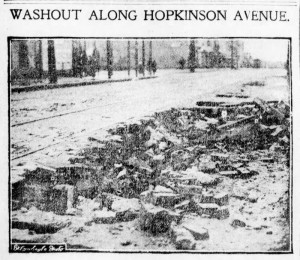THE GREAT BROOKLYN FLOOD OF 1903

Brownstone Detectives investigates the history of our clients’ homes.
The story you are about to read was composed from research conducted in the course of one of those investigations.
Do you know the history of YOUR house?
********************************************************************************************************************************
By 7 a.m. on Friday, 9 October 1903, the cellars all along Macon Street were completely inundated with water that was rising quickly toward the basement joists. Without let up, the turgid brown waters continued to pour into the homes through the under-stoop doorways until the floodwaters had reached the level of the basement windowsills, whereupon it then began to pour also through the windows and into the basement dining rooms.

The Ocean Hill area, like much of Brooklyn, had fallen victim of the heavy rains that had been falling continuously for much of the night.
All the residences along Hancock, McDonough, Macon, Decatur, Bainbridge and Chauncey Streets were so flooded that residents on the ground floor apartments discovered upon waking that they were forced to go to the second floors to escape the waters.
“IN SARATOGA PARK…BENCHES WERE FLOATING ABOUT…”

The paths in Saratoga Park, according to one newspaper account, “had become running streams and benches were floating about.” The nearby Putnam and Halsey streetcars stopped running, as “it was impossible to take on any passengers, as the water was as high as the seats.”
Streets and sidewalks were submerged under several inches of water, and, eventually, furniture moving vans were pressed into service by the police to be used in saving people from their houses.
By 8 a.m., the total rainfall had reached 6.42 inches, and it was still pouring. By noon, this figure increased to 8 inches. When the deluge finally abated that evening, a total of nearly a foot of water had inundated the City during a 30-hour period – the highest rainfall on record, equaling about three months’ normal rainfall in one day.

THE OUTCOME AS IT WAS THEN MEASURED
In the end, because of the actual elevations of certain parts of town, many sections of the Eastern District of Brooklyn had flooded with three to seven feet of water. It would take weeks for the fire department to pump water out of all the residents’ cellars.
It was estimated in another newspaper article that 240 million tons of water had fallen on Greater New York City area alone, or 7 billion gallons. In an attempt at giving a visual perspective to these amounts, it was said that the rainwater, if it had been collected in a single tank as big as Central Park, would easily measure more than 200 feet deep.
BUT WHAT TO DO
Brooklyn citizens were grumbling, though, not so much at the gods who’d brought them the rains, but at the borough’s leadership which, in their estimation, had given them inadequate sewers.

The newspapers of the time are replete with stories about Brooklyn’s sewers – many going back to the 1850s – and how the system has neither alleviated or addressed, even in part, the removal and relief of rainwater from city streets.
The City’s Chief Engineer was inclined to agree. Yet he went a step further in divining the reasons behind and predicting the future of the city’s deluges, addressing the “radical change in the climatic conditions which regulate the rainfall of Brooklyn.
“I have been devoting the greater part of my time and thought to this problem,” he declared, “as I am coming to believe, climatic changes are going on which will make a rainfall from 3 to 5 inches an hour a thing of ordinary occurrence, it means that the present sewer system of Brooklyn is entirely inadequate and we must draw plans and make preparations for doubling the capacity of our system.
“In years gone by a rainfall of more than 2 or 3 inches in an hour occurred only once or twice in a decade. Now we are getting 4 or 5 inches in an hour two or three times a year.”
Many residents figured that not much would be done, and that laughing about the water was the best they could do, including wondering whether the city, in place of updating sewers, should simply consider the better alternative.
Building an ark.

———————————————————————————————————————–
 Brownstone Detectives is an historic property research agency. Our mission is to document and save the histories of our clients’ homes. From our research, we produce our celebrated House History Books and House History Reports. Contact us today to begin discovering the history of your home.
Brownstone Detectives is an historic property research agency. Our mission is to document and save the histories of our clients’ homes. From our research, we produce our celebrated House History Books and House History Reports. Contact us today to begin discovering the history of your home.